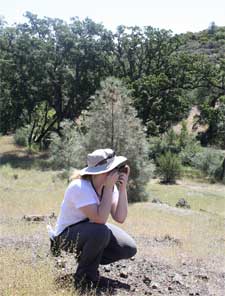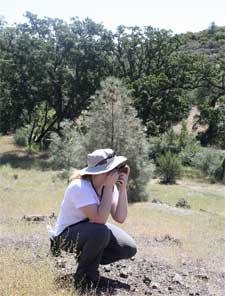 KINGSTON, R.I. – January 3, 2012 – University of Rhode Island senior Ashley McCann had a rock collection as a child and recalls being motivated when her high school earth science teacher introduced her to the study of geology. But she didn’t imagine that her fledgling interest in rocks would lead to an investigation of life on Mars.
KINGSTON, R.I. – January 3, 2012 – University of Rhode Island senior Ashley McCann had a rock collection as a child and recalls being motivated when her high school earth science teacher introduced her to the study of geology. But she didn’t imagine that her fledgling interest in rocks would lead to an investigation of life on Mars.
“Mars has a very thin atmosphere and it’s constantly being bombarded with cosmic radiation and charged particles from our own Sun, so nothing can survive on the surface,” said McCann, a resident of Vernon, Conn., and president of the URI Geology Club. “But life could exist in the subsurface if conditions are right and liquid water exists, and the presence of serpentine minerals suggests this may be so.”
Working in collaboration with URI Assistant Professor Dawn Cardace, McCann spent the last eight months conducting a field study of serpentinite, a rock composed primarily of minerals produced when water reacts with rocks from Earth’s mantle and which have become exposed on Earth’s surface due to plate tectonics. Recent remotely sensed data suggest serpentine is also found on Mars. Unusual microbial life has been detected in waters flushed from serpentinite on Earth, and scientists seek to determine whether serpentine on Mars may also host microbial life.
“If life is on Mars, it’s going to be microbial and it’s going to be in the subsurface,” she said.
To verify the remote mapping of serpentine on Mars, McCann surveyed a serpentinite ecosystem in Northern California last summer, collecting samples of the rock at McLaughlin Natural Reserve in Lower Lake, Cal. She spent the last several months conducting an analysis of the minerals found in the rocks using x-ray diffraction technology to compare them to the minerals known to be on Mars. She found them to be very similar.
The URI student presented her research last month at the annual meeting of the American Geophysical Union, the largest gathering of earth scientists in the world. “I networked with scientists from all over the world, and they were very encouraging about my work,” she said. “I hope to further this project as my senior thesis.”
Her research was conducted as part of the URI Coastal Fellows Program, an initiative designed to involve undergraduate students in addressing current environmental problems. Now in its 16th year, it is based at URI’s College of the Environment and Life Sciences. Students are paired with a mentor and research staff to help them gain skills relevant to their academic major and future occupations.
McCann is looking forward to gaining additional geology experience next summer when she participates in a six- to eight-week field camp, traveling and studying the geology of the Midwest, learning the use of field tools and mapping techniques, and meeting aspiring geologists from around the country.
Despite her enthusiasm for geology, she is uncertain about her future career path. She is strongly considering enrolling in the Peace Corps to help impoverished countries improve their agricultural practices before attending graduate school.
As a student majoring in both geology and wildlife biology, she said she has “concocted a plan to combine these two studies,” perhaps working for the U.S. Fish and Wildlife Service evaluating critical habitat for endangered species.
“For a very long time I had wanted to be a veterinarian, and I know I want to keep animals in my life in some way,” McCann said.
Or perhaps she will return to the McLaughlin Natural Reserve, a former gold mine, where they need geologists to help in remediation efforts.
“The Earth in general and all of its life forms and processes are what interest me most,” she concluded.

